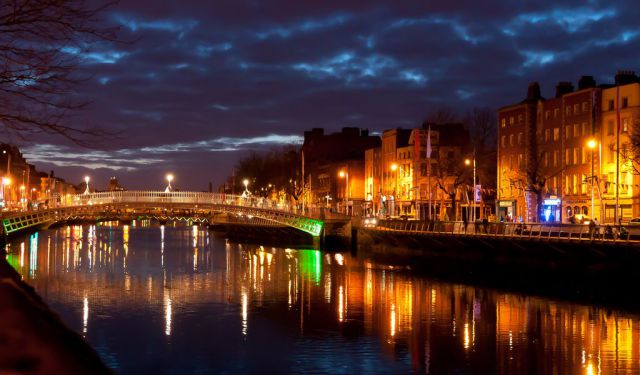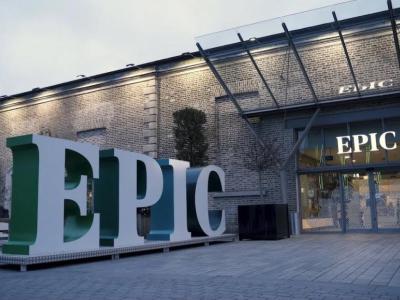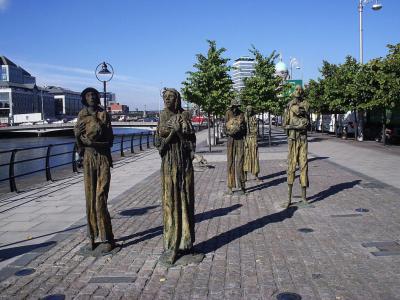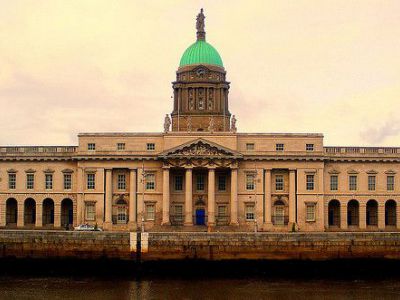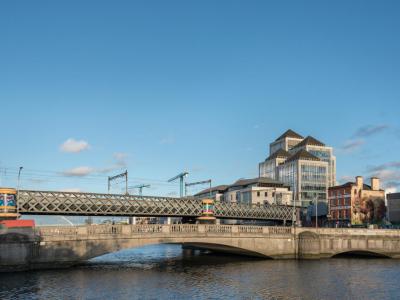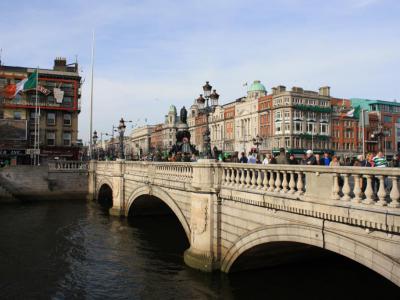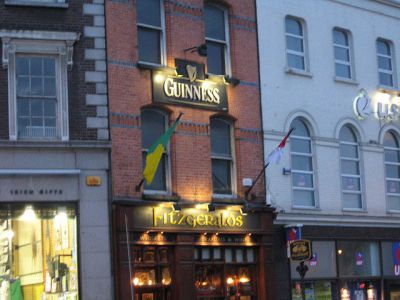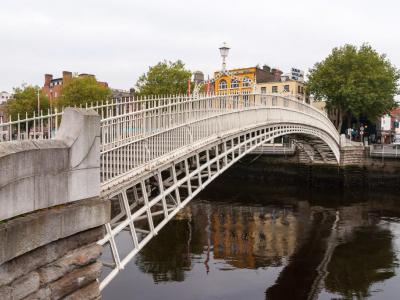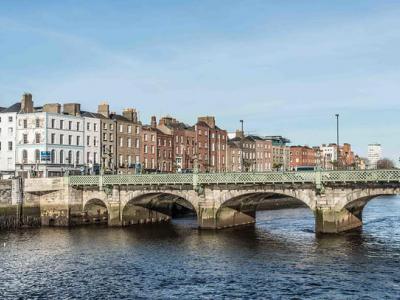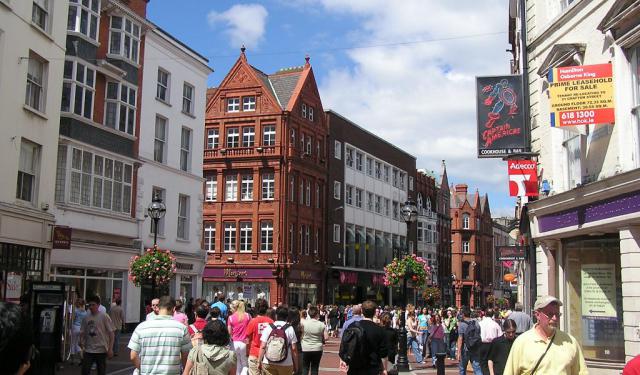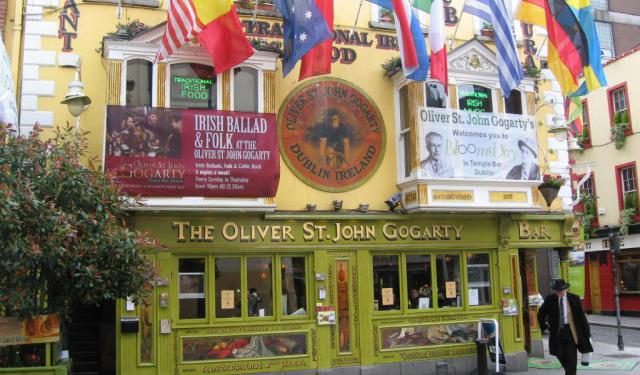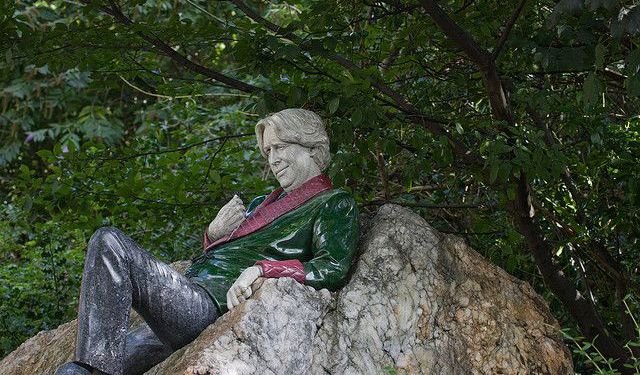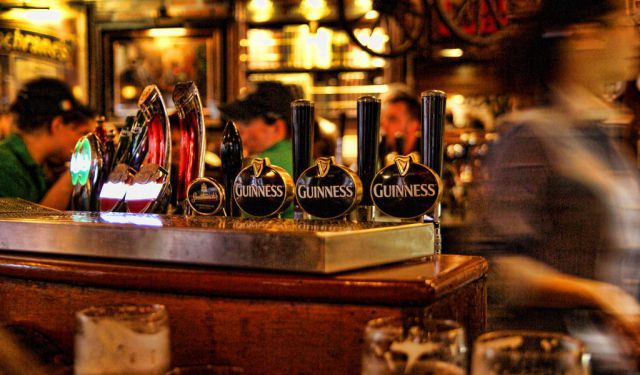Audio Guide: A Walk Along Liffey River (Self Guided), Dublin
The River Liffey - Dublin’s liquid backbone - slices through the Irish capital like a great shimmering bookmark, separating the Northside from the Southside in a civil yet longstanding sibling rivalry. Stretching around 125 kilometers, this body of water is indeed a living archive, a story that never quite ends. Stroll along its banks, and you’ll find yourself time-traveling without the hassle of quantum physics. From rebel lore to literary ghosts, every ripple and reflection holds a piece of Dublin’s soul.
First up, the Samuel Beckett Bridge - part bridge, part giant harp impersonator - elegantly strums the skyline. Designed by Spanish starchitect Santiago Calatrava, it looks as if Dublin asked for a modern icon and got a poetic overachiever.
A bit further down, EPIC: The Irish Emigration Museum doesn’t just tell stories - it grabs your hand and whisks you through generations of Irish who made the world their home, one tear-stained goodbye at a time...
Not far from there, the Famine Memorial quietly tugs at your conscience. These bronze figures don’t shout; they murmur of hunger, resilience, and the scars left between 1845 and 1852 - a heavy pause in the city’s heartbeat.
Now look up - the Custom House, built in the late 1700s, still shows off like it’s auditioning for a Jane Austen adaptation. Designed by James Gandon, it’s neoclassical drama with a Georgian twist: all pillars, domes, and unapologetic grandeur.
Then there’s Butt Bridge (no snickering, please) named after Isaac Butt, the man who championed Irish Home Rule. Not everyone gets a bridge, but he earned it.
Feeling thirsty? Fitzgerald’s pub stands nearby like an old friend with great taste in beer. Step inside for a proper pint and perhaps a bit of live banter - the kind that turns into stories the next day.
Certainly, you can miss the Ha’penny Bridge - Dublin’s sweetheart since 1816. Cast iron never looked so charming. Cross it, and you’re not just changing sides - you’re stepping into the past, where thousands have left footprints and maybe the occasional love letter.
And finally, Grattan Bridge-a flat-footed beauty catwalk over the river-where history, architecture, and city views still compete for your attention.
So there you have it - the Liffey - a river, a living museum, a romantic stroll, a quiet elegy, and a boisterous laugh - all rolled into one. Want to dive deeper? Take this self-guided walk and let Dublin whisper its secrets as you go.
First up, the Samuel Beckett Bridge - part bridge, part giant harp impersonator - elegantly strums the skyline. Designed by Spanish starchitect Santiago Calatrava, it looks as if Dublin asked for a modern icon and got a poetic overachiever.
A bit further down, EPIC: The Irish Emigration Museum doesn’t just tell stories - it grabs your hand and whisks you through generations of Irish who made the world their home, one tear-stained goodbye at a time...
Not far from there, the Famine Memorial quietly tugs at your conscience. These bronze figures don’t shout; they murmur of hunger, resilience, and the scars left between 1845 and 1852 - a heavy pause in the city’s heartbeat.
Now look up - the Custom House, built in the late 1700s, still shows off like it’s auditioning for a Jane Austen adaptation. Designed by James Gandon, it’s neoclassical drama with a Georgian twist: all pillars, domes, and unapologetic grandeur.
Then there’s Butt Bridge (no snickering, please) named after Isaac Butt, the man who championed Irish Home Rule. Not everyone gets a bridge, but he earned it.
Feeling thirsty? Fitzgerald’s pub stands nearby like an old friend with great taste in beer. Step inside for a proper pint and perhaps a bit of live banter - the kind that turns into stories the next day.
Certainly, you can miss the Ha’penny Bridge - Dublin’s sweetheart since 1816. Cast iron never looked so charming. Cross it, and you’re not just changing sides - you’re stepping into the past, where thousands have left footprints and maybe the occasional love letter.
And finally, Grattan Bridge-a flat-footed beauty catwalk over the river-where history, architecture, and city views still compete for your attention.
So there you have it - the Liffey - a river, a living museum, a romantic stroll, a quiet elegy, and a boisterous laugh - all rolled into one. Want to dive deeper? Take this self-guided walk and let Dublin whisper its secrets as you go.
How it works: Download the app "GPSmyCity: Walks in 1K+ Cities" from Apple App Store or Google Play Store to your mobile phone or tablet. The app turns your mobile device into a personal tour guide and its built-in GPS navigation functions guide you from one tour stop to next. The app works offline, so no data plan is needed when traveling abroad.
A Walk Along Liffey River Map
Guide Name: A Walk Along Liffey River
Guide Location: Ireland » Dublin (See other walking tours in Dublin)
Guide Type: Self-guided Walking Tour (Sightseeing)
# of Attractions: 9
Tour Duration: 1 Hour(s)
Travel Distance: 2.1 Km or 1.3 Miles
Author: max
Sight(s) Featured in This Guide:
Guide Location: Ireland » Dublin (See other walking tours in Dublin)
Guide Type: Self-guided Walking Tour (Sightseeing)
# of Attractions: 9
Tour Duration: 1 Hour(s)
Travel Distance: 2.1 Km or 1.3 Miles
Author: max
Sight(s) Featured in This Guide:
- Samuel Beckett Bridge
- EPIC The Irish Emigration Museum
- Famine Memorial
- Custom House
- Butt Bridge
- O'Connell Bridge
- Fitzgerald's Bar
- Ha'penny Bridge
- Grattan Bridge
1) Samuel Beckett Bridge
Dublin’s charm... It’s where Irish warmth throws a wink at continental style-and somehow, they get along famously. The city hums with energy these days, but the legendary hospitality hasn’t packed up and left. It just adapted to faster Wi-Fi.
Take the Samuel Beckett Bridge, for example. One of Dublin’s most iconic modern landmarks-both a feat of engineering and a tribute to creativity. Sleek, modern, and just a bit dramatic-exactly what you’d expect from something designed by Spanish starchitect Santiago Calatrava, with the help from a local engineering firm to keep things grounded.
His second bridge in the area (after the James Joyce Bridge upstream) is a kind of architectural encore, and it took about five years to complete. Clearly, the man has a soft spot for literary crossings. This one is named after Samuel Beckett, the Nobel Prize-winning Irish playwright best known for his “Waiting for Godot.” Quite fitting, really-it's a bridge that goes somewhere, unlike his famously static characters...
Now, about the design: imagine a harp gently tipped on its side. That’s no accident but a deliberate nod to Ireland’s ancient national symbol, dating back to the 13th century, seen on numerous coins and coats of arms throughout the country. And yes, this sideways stringed beauty cost a cool €60 million. Opened in December 2009 by the Lord Mayor, Emer Costello, it links the Liffey’s north and south banks and has since become a runway for fast-walking commuters and distracted texters alike. The structure rotates horizontally to allow ships to pass, thus adding a bit of drama to the Liffey’s usual flow.
But here’s the twist: no matter how rushed folks are, that bridge has a way of making people look up. And when the evening quiet settles in, it’s pure magic-city lights twinkling in the water, reflections doing their own little Riverdance...
Pro tip:
Before you call it a day, pop over to the rooftop bar at The Mayson for the stunning views, killer cocktails, and a breeze that whispers, “You might never leave”...
Take the Samuel Beckett Bridge, for example. One of Dublin’s most iconic modern landmarks-both a feat of engineering and a tribute to creativity. Sleek, modern, and just a bit dramatic-exactly what you’d expect from something designed by Spanish starchitect Santiago Calatrava, with the help from a local engineering firm to keep things grounded.
His second bridge in the area (after the James Joyce Bridge upstream) is a kind of architectural encore, and it took about five years to complete. Clearly, the man has a soft spot for literary crossings. This one is named after Samuel Beckett, the Nobel Prize-winning Irish playwright best known for his “Waiting for Godot.” Quite fitting, really-it's a bridge that goes somewhere, unlike his famously static characters...
Now, about the design: imagine a harp gently tipped on its side. That’s no accident but a deliberate nod to Ireland’s ancient national symbol, dating back to the 13th century, seen on numerous coins and coats of arms throughout the country. And yes, this sideways stringed beauty cost a cool €60 million. Opened in December 2009 by the Lord Mayor, Emer Costello, it links the Liffey’s north and south banks and has since become a runway for fast-walking commuters and distracted texters alike. The structure rotates horizontally to allow ships to pass, thus adding a bit of drama to the Liffey’s usual flow.
But here’s the twist: no matter how rushed folks are, that bridge has a way of making people look up. And when the evening quiet settles in, it’s pure magic-city lights twinkling in the water, reflections doing their own little Riverdance...
Pro tip:
Before you call it a day, pop over to the rooftop bar at The Mayson for the stunning views, killer cocktails, and a breeze that whispers, “You might never leave”...
2) EPIC The Irish Emigration Museum
Dubbed by The Irish Times as the “world’s first fully digital museum,” EPIC isn’t your average hall of dusty artifacts and fading family trees. Nope-this is where history gets a tech upgrade: motion sensors, glowing walls, and interactive everything-all telling the epic tale of some 70 million people with Irish roots worldwide.
Why did they leave? Where did they land? And how did they keep the “hundred thousand welcomes” (a universal Irish greeting) spirit alive across oceans? EPIC dives into all that with flair.
The mastermind behind it is Neville Isdell-former Coca-Cola boss and proud son of County Down. He poured fizz and vision into the project, and in May 2016, former Irish President Mary Robinson officially popped the cork and opened the doors.
The accolades came fast: shortlisted for “European Museum of the Year” in 2018, and by 2019, crowned “Europe’s Leading Tourist Attraction” at the World Travel Awards. Not bad for a newbie...
Designed by the same folks who brought you Titanic Belfast (don’t worry, this one doesn’t sink), EPIC features 20 immersive galleries split into four themes: Migration, Motivation, Influence, and Diaspora Today.
First stop: Migration (galleries 1 to 2)-offers a journey through Irish movement since 500 AD. Then, Motivation (galleries 4-7): explores why they left-famine, faith, conflict, and, in some cases, a gentle shove from the legal system. In Influence (galleries 8-18), you’ll meet Irish trailblazers in music, politics, sports, science, and even food. And, finally, Diaspora Today (galleries 19-20)-that’s where the global Irish story lives on-via parades, parties, and a rogue’s gallery of heritage-infused mischief-makers.
In short, the EPIC museum is more like a digital love letter to the Irish who packed their bags-and never lost the plot...
Why did they leave? Where did they land? And how did they keep the “hundred thousand welcomes” (a universal Irish greeting) spirit alive across oceans? EPIC dives into all that with flair.
The mastermind behind it is Neville Isdell-former Coca-Cola boss and proud son of County Down. He poured fizz and vision into the project, and in May 2016, former Irish President Mary Robinson officially popped the cork and opened the doors.
The accolades came fast: shortlisted for “European Museum of the Year” in 2018, and by 2019, crowned “Europe’s Leading Tourist Attraction” at the World Travel Awards. Not bad for a newbie...
Designed by the same folks who brought you Titanic Belfast (don’t worry, this one doesn’t sink), EPIC features 20 immersive galleries split into four themes: Migration, Motivation, Influence, and Diaspora Today.
First stop: Migration (galleries 1 to 2)-offers a journey through Irish movement since 500 AD. Then, Motivation (galleries 4-7): explores why they left-famine, faith, conflict, and, in some cases, a gentle shove from the legal system. In Influence (galleries 8-18), you’ll meet Irish trailblazers in music, politics, sports, science, and even food. And, finally, Diaspora Today (galleries 19-20)-that’s where the global Irish story lives on-via parades, parties, and a rogue’s gallery of heritage-infused mischief-makers.
In short, the EPIC museum is more like a digital love letter to the Irish who packed their bags-and never lost the plot...
3) Famine Memorial
Situated just east of Dublin’s Custom House is one of the city’s most evocative memorials-a stark tribute to a time of suffering etched deep into Ireland’s collective memory. Simply titled “Famine,” this haunting assembly of life-sized bronze figures was unveiled in 1998, produced by Irish sculptor Rowan Gillespie. A piece of art, it stands largely as a testimony.
These gaunt forms, cast in bronze but heavy with human sorrow, commemorate the Great Hunger of 1845 to 1851-one of the darkest chapters in Ireland’s past. Their hollow eyes and emaciated frames speak volumes where words fail, capturing the despair of those who once trudged toward uncertain futures, driven from their homeland by starvation and despair.
Positioned along the River Liffey, the sculptures face east, toward the Irish Sea-and, perhaps with quiet accusation, toward Britain. Behind them rises the modern sheen of the Allied Irish Bank, a cruel contrast to the poverty and neglect these figures recall. The location itself amplifies the memorial’s message, placing the memory of loss directly within the current of present-day commerce and movement.
During the years of famine, over one million people perished. Another million fled, often boarding the so-called “coffin ships” (a common nickname for the overcrowded, unsanitary vessels, with high mortality rates due to disease and poor conditions) bound for distant shores. The population of Ireland was effectively halved-a wound from which the country would never fully recover. In recognition of this far-reaching tragedy, a sister installation was unveiled in Toronto in 2007, at Ireland Park, honouring those who found refuge across the Atlantic.
Together, these sculptures form a silent procession-forever walking, forever remembered...
These gaunt forms, cast in bronze but heavy with human sorrow, commemorate the Great Hunger of 1845 to 1851-one of the darkest chapters in Ireland’s past. Their hollow eyes and emaciated frames speak volumes where words fail, capturing the despair of those who once trudged toward uncertain futures, driven from their homeland by starvation and despair.
Positioned along the River Liffey, the sculptures face east, toward the Irish Sea-and, perhaps with quiet accusation, toward Britain. Behind them rises the modern sheen of the Allied Irish Bank, a cruel contrast to the poverty and neglect these figures recall. The location itself amplifies the memorial’s message, placing the memory of loss directly within the current of present-day commerce and movement.
During the years of famine, over one million people perished. Another million fled, often boarding the so-called “coffin ships” (a common nickname for the overcrowded, unsanitary vessels, with high mortality rates due to disease and poor conditions) bound for distant shores. The population of Ireland was effectively halved-a wound from which the country would never fully recover. In recognition of this far-reaching tragedy, a sister installation was unveiled in Toronto in 2007, at Ireland Park, honouring those who found refuge across the Atlantic.
Together, these sculptures form a silent procession-forever walking, forever remembered...
4) Custom House
The Custom House is Dublin’s answer to the expression: “Go big or go home.” Born in 1791, this stately giant is one of James Gandon’s architectural flexes, joining his other local hits like the Four Courts and O’Connell Bridge. It cost a jaw-dropping £500,000 sterling to build-partly because it’s massive, partly because Gandon had a thing for details, and mostly because it’s sitting on what used to be a soggy mudflat. To make sure it didn’t sink like your average late-night decision, builders laid it on a forest of pine planks. Fancy solution...
Ironically, just nine years later, the Act of Union decided customs duties belonged in London. So, this grand monument to Irish trade was suddenly... unemployed.
Still, the building held its head high-or rather, its 35-metre dome, modeled after that by Christopher Wren at London’s Greenwich Hospital. Its long Neoclassical façade is peppered with sculptures by Edward Smyth: river gods, cattle heads, and other stone-faced symbols of Ireland’s economy. Above the entrance, the Liffey itself watches over with appropriate gravitas.
After being repurposed for various municipal administrative duties-such as public hygiene, poor relief, and even accommodating, at one point, a huge Famine pot-the building faced calamities. A devastating fire in 1833 and deliberate torching by the IRA in 1921 are just a few of them. Still, in the style befitting a great diva, the structure made a remarkable comeback-painstakingly refurbished, slightly altered both inside and out, but still stealing the show...
Apart from government departments, over the years, the Custom House has also accommodated all sorts of characters, including comic novelist Flann O’Brien and the ever-melodic songwriter and author Percy French.
You don’t need to go inside to feel its presence; a lap around the building offers plenty of architectural eye-candy. And for that chef’s kiss Instagram moment, cross to the south side of the river. Trust us-your camera won't be disappointed.
Ironically, just nine years later, the Act of Union decided customs duties belonged in London. So, this grand monument to Irish trade was suddenly... unemployed.
Still, the building held its head high-or rather, its 35-metre dome, modeled after that by Christopher Wren at London’s Greenwich Hospital. Its long Neoclassical façade is peppered with sculptures by Edward Smyth: river gods, cattle heads, and other stone-faced symbols of Ireland’s economy. Above the entrance, the Liffey itself watches over with appropriate gravitas.
After being repurposed for various municipal administrative duties-such as public hygiene, poor relief, and even accommodating, at one point, a huge Famine pot-the building faced calamities. A devastating fire in 1833 and deliberate torching by the IRA in 1921 are just a few of them. Still, in the style befitting a great diva, the structure made a remarkable comeback-painstakingly refurbished, slightly altered both inside and out, but still stealing the show...
Apart from government departments, over the years, the Custom House has also accommodated all sorts of characters, including comic novelist Flann O’Brien and the ever-melodic songwriter and author Percy French.
You don’t need to go inside to feel its presence; a lap around the building offers plenty of architectural eye-candy. And for that chef’s kiss Instagram moment, cross to the south side of the river. Trust us-your camera won't be disappointed.
5) Butt Bridge
Tilt your head just a little, and you’ll match the angle of this curious character stretched across the River Liffey - linking George's Quay with Beresford Place like it’s trying to start a conversation between south and north Dublin. It might not have the Instagram glow of the Ha’Penny or the architectural swagger of the Samuel Beckett Bridge, but this old soul has charm where it counts. It’s got grit, grace, and a pretty smashing view of the Docklands, the Custom House, and a river that’s heard more stories than your favorite pub.
The original bridge was built in 1879 as a steel swivel bridge to allow ships to pass through, back when the Liffey still saw serious maritime action. It was named after Isaac Butt-a 19th-century Irish nationalist who fought for the country’s autonomy and just so happened to die that same year (talk about timing...).
Eventually, as Dublin modernised and traffic increased, the swing bridge became more of a bottleneck than a solution and demanded a sturdier replacement. So, in 1932, the swing section was replaced with the current fixed, three-span, granite-trimmed chunk of ferro-concrete, still carrying Butt’s name and a healthy dose of old-school pride. Practical, sturdy, and very 1930s...
But here’s the kicker - the middle section of this bridge is a marvel: two cantilevered arms reaching out like they’re shaking hands, perfectly balanced by their own approach spans. This was the first time reinforced concrete pulled off such a trick in Britain or Ireland. So, yeah, it may look modest, but under that grey exterior is a quiet revolution in concrete couture.
The bridge is just downstream from the Samuel Beckett and Rosie Hackett Bridges-so, if you’re into Dublin’s literary heritage, you’re standing in good company. And if you want a bonus fun fact for your walk: you’re crossing over the Liffey in the footsteps of countless Dubs from every walk of life-including possibly your own inner poet...
The original bridge was built in 1879 as a steel swivel bridge to allow ships to pass through, back when the Liffey still saw serious maritime action. It was named after Isaac Butt-a 19th-century Irish nationalist who fought for the country’s autonomy and just so happened to die that same year (talk about timing...).
Eventually, as Dublin modernised and traffic increased, the swing bridge became more of a bottleneck than a solution and demanded a sturdier replacement. So, in 1932, the swing section was replaced with the current fixed, three-span, granite-trimmed chunk of ferro-concrete, still carrying Butt’s name and a healthy dose of old-school pride. Practical, sturdy, and very 1930s...
But here’s the kicker - the middle section of this bridge is a marvel: two cantilevered arms reaching out like they’re shaking hands, perfectly balanced by their own approach spans. This was the first time reinforced concrete pulled off such a trick in Britain or Ireland. So, yeah, it may look modest, but under that grey exterior is a quiet revolution in concrete couture.
The bridge is just downstream from the Samuel Beckett and Rosie Hackett Bridges-so, if you’re into Dublin’s literary heritage, you’re standing in good company. And if you want a bonus fun fact for your walk: you’re crossing over the Liffey in the footsteps of countless Dubs from every walk of life-including possibly your own inner poet...
6) O'Connell Bridge
O'Connell Bridge - the only bridge in Europe that is wider than it is long. Yet somehow it still manages to be one of Dublin's most photogenic overachievers.
Its charm isn’t just in the sweeping view of the Liffey - no, it’s in the fine print: delicate sandstone balustrades, floral garlands clinging to the piers like Victorian jewelry, and lamp posts that look like they wandered in from a Parisian boulevard and forgot to leave. There are even hidden stone steps tucked along the western quay like a secret stairway for time-traveling flâneurs.
Originally, this spot was home to Carlisle Bridge, a 1794 creation by James Gandon - the same fellow behind half the serious-looking buildings in Dublin. Back then, crossing it meant gliding from Sackville Street (now known as O’Connell Street) toward Trinity College and the Houses of Parliament with the kind of architectural drama that only powdered wigs and carriages could pull off.
But, alas, the 19th century happened. The bridge aged, traffic boomed, and the old beauty started wheezing under the strain. All this called for the new model: a broader, bolder, smoother sibling with classic looks and modern stamina. Officially opened in 1880, it was proudly named after the national hero Daniel O’Connell - because sometimes “upgrade” implies tripling the width and slapping a Liberator’s name on it...
Today, O’Connell Bridge may no longer be the only crossing in town, but it still holds court. Peer to the east for the stately Custom House, or look west for the Four Courts, and you realize you’re standing not just on granite and history, but on a very Dublin kind of grandeur - understated, slightly eccentric, and always watching the river go by.
Its charm isn’t just in the sweeping view of the Liffey - no, it’s in the fine print: delicate sandstone balustrades, floral garlands clinging to the piers like Victorian jewelry, and lamp posts that look like they wandered in from a Parisian boulevard and forgot to leave. There are even hidden stone steps tucked along the western quay like a secret stairway for time-traveling flâneurs.
Originally, this spot was home to Carlisle Bridge, a 1794 creation by James Gandon - the same fellow behind half the serious-looking buildings in Dublin. Back then, crossing it meant gliding from Sackville Street (now known as O’Connell Street) toward Trinity College and the Houses of Parliament with the kind of architectural drama that only powdered wigs and carriages could pull off.
But, alas, the 19th century happened. The bridge aged, traffic boomed, and the old beauty started wheezing under the strain. All this called for the new model: a broader, bolder, smoother sibling with classic looks and modern stamina. Officially opened in 1880, it was proudly named after the national hero Daniel O’Connell - because sometimes “upgrade” implies tripling the width and slapping a Liberator’s name on it...
Today, O’Connell Bridge may no longer be the only crossing in town, but it still holds court. Peer to the east for the stately Custom House, or look west for the Four Courts, and you realize you’re standing not just on granite and history, but on a very Dublin kind of grandeur - understated, slightly eccentric, and always watching the river go by.
7) Fitzgerald's Bar
If you find yourself wandering Dublin’s Temple Bar district-somewhere between a photo-op and a Guinness-make a beeline to 22 Aston Quay, where Fitzgerald’s Bar has been charming the thirsty and the curious since long before your GPS was born.
Tucked inside a 19th-century building that looks like it could tell you a few stories (and probably has), Fitzgerald’s is the kind of place where time politely steps aside for a pint. Here it is, a Victorian bar with creaky wooden floors, soaring ceilings, wrought-iron chandeliers, and mirrors that might accidentally show you enjoying your third Guinness a bit too much. As a bonus, you can always make use of those intimate alcoves-perfect for whispering sweet nothings or your opinion on the match.
This is your daytime pitstop and your nighttime launchpad. Whether you're just off the hop-on/hop-off bus or staging an impromptu pub crawl, Fitzgerald’s has your back-with shepherd’s pie, fried cod, corned beef, and an all-day breakfast that laughs in the face of time. Meanwhile, the TVs juggle sports and soaps with the grace of a caffeinated bartender.
Craving a quiet nook? There’s a snug in the back where you can plot world domination or just enjoy your pint in peace.
With a well-stocked arsenal of ales, stouts, lagers, and a staff that’s as warm as the lighting, Fitzgerald’s serves charm by the glassful. Add in occasional live music and a crowd that knows when to cheer and when to chill, and you’ve got yourself a quintessentially Irish experience with none of the clichés-except the ones you came for...
Open daily, feeding both bellies and spirits from morning to night, Fitzgerald’s is a pub and a perfectly poured slice of Dublin rolled into one.
Tucked inside a 19th-century building that looks like it could tell you a few stories (and probably has), Fitzgerald’s is the kind of place where time politely steps aside for a pint. Here it is, a Victorian bar with creaky wooden floors, soaring ceilings, wrought-iron chandeliers, and mirrors that might accidentally show you enjoying your third Guinness a bit too much. As a bonus, you can always make use of those intimate alcoves-perfect for whispering sweet nothings or your opinion on the match.
This is your daytime pitstop and your nighttime launchpad. Whether you're just off the hop-on/hop-off bus or staging an impromptu pub crawl, Fitzgerald’s has your back-with shepherd’s pie, fried cod, corned beef, and an all-day breakfast that laughs in the face of time. Meanwhile, the TVs juggle sports and soaps with the grace of a caffeinated bartender.
Craving a quiet nook? There’s a snug in the back where you can plot world domination or just enjoy your pint in peace.
With a well-stocked arsenal of ales, stouts, lagers, and a staff that’s as warm as the lighting, Fitzgerald’s serves charm by the glassful. Add in occasional live music and a crowd that knows when to cheer and when to chill, and you’ve got yourself a quintessentially Irish experience with none of the clichés-except the ones you came for...
Open daily, feeding both bellies and spirits from morning to night, Fitzgerald’s is a pub and a perfectly poured slice of Dublin rolled into one.
8) Ha'penny Bridge
Ask any Dubliner to name their favourite landmark, and odds are the Ha’penny Bridge will trot out at the top like a local celebrity on a victory lap. As you meander through the heart of the city, there’s a good chance you’ll end up crossing this charming cast-iron icon - Dublin’s oldest and most lovingly overphotographed pedestrian bridge, gracefully linking the north and south sides like a Victorian-era handshake.
It first opened in 1816 as the Wellington Bridge, but truth be told - nobody calls it that. The nickname "Ha’penny" stuck faster than a pub story, thanks to the halfpenny toll it once charged, which matched the fee for the seven ferries it put out of business. For a time, inflation did its thing, and the toll rose to a penny and a half, prompting locals to cheekily dub it the "Penny Ha’penny Bridge." Now, try saying that three times fast after a dram or two...
These days, crossing it is free - financially, at least. Emotionally? Well, that’s another story. Leaning against the railing under the old lanterns, taking in the ripple of the Liffey and watching Dublin unfold on either bank, you might find yourself wishing you could pay a toll just to stand here a little longer. But beware: stand still too long and you’ll find yourself getting nudged by folks who are just trying to get to work, rather than star in a romantic travel montage...
So keep it moving, take a mental snapshot, and know that for one glorious moment, you crossed a bridge that’s as much a part of Dublin’s soul as the Guinness in its veins.
It first opened in 1816 as the Wellington Bridge, but truth be told - nobody calls it that. The nickname "Ha’penny" stuck faster than a pub story, thanks to the halfpenny toll it once charged, which matched the fee for the seven ferries it put out of business. For a time, inflation did its thing, and the toll rose to a penny and a half, prompting locals to cheekily dub it the "Penny Ha’penny Bridge." Now, try saying that three times fast after a dram or two...
These days, crossing it is free - financially, at least. Emotionally? Well, that’s another story. Leaning against the railing under the old lanterns, taking in the ripple of the Liffey and watching Dublin unfold on either bank, you might find yourself wishing you could pay a toll just to stand here a little longer. But beware: stand still too long and you’ll find yourself getting nudged by folks who are just trying to get to work, rather than star in a romantic travel montage...
So keep it moving, take a mental snapshot, and know that for one glorious moment, you crossed a bridge that’s as much a part of Dublin’s soul as the Guinness in its veins.
9) Grattan Bridge
Dublin’s own riverside peacock, showing off its symmetrical feathers-Grattan Bridge is where aesthetics meet engineering with suspicious grace. Peer northward from its spine and you'll spot Capel Street: still strutting its 17th-century flair like it never got the memo that centuries changed. Swing your gaze south and-voilà-City Hall, complete with an 18th-century portico and a copper dome that insists on being admired, even on cloudy days.
But before it was Grattan, it was Essex Bridge, born in 1676 as Dublin’s third river crossing and the easternmost handshake between two very different worlds. On one side: Capel Street, once dotted with trendy Dutch-style mansions. On the other: a snarl of medieval alleyways that might have led to adventure-or just a misplaced chamber pot...
Back in the day, locals perched here to watch ships float in, sails puffed like proud chests, unloading spices, silks, and whatever else smelled expensive enough to get sniffed by the customs house. In 1722, a statue of King George I was plonked nearby-an English king who, in a delicious twist, couldn’t speak English.
Essex Bridge, however, had commitment issues with stability. Its foundations were laid directly on the riverbed-brave, but foolish-meaning the Liffey’s every mood swing resulted in structural drama. So, in 1874, a major glow-up occurred. Renamed after Henry Grattan (the Irish politician who campaigned for legislative freedom for the Irish Parliament in the late 18th century), the bridge was flattened for modern traffic and widened with stylish cantilevered footpaths, wrought iron railings, and those romantic lamps perfect for late-night philosophizing.
A final facelift in 2002 gave it sturdier bones and smoother pedestrian walks, ensuring Grattan Bridge keeps serving looks-and foot traffic-in Dublin's ever-evolving cityscape.
But before it was Grattan, it was Essex Bridge, born in 1676 as Dublin’s third river crossing and the easternmost handshake between two very different worlds. On one side: Capel Street, once dotted with trendy Dutch-style mansions. On the other: a snarl of medieval alleyways that might have led to adventure-or just a misplaced chamber pot...
Back in the day, locals perched here to watch ships float in, sails puffed like proud chests, unloading spices, silks, and whatever else smelled expensive enough to get sniffed by the customs house. In 1722, a statue of King George I was plonked nearby-an English king who, in a delicious twist, couldn’t speak English.
Essex Bridge, however, had commitment issues with stability. Its foundations were laid directly on the riverbed-brave, but foolish-meaning the Liffey’s every mood swing resulted in structural drama. So, in 1874, a major glow-up occurred. Renamed after Henry Grattan (the Irish politician who campaigned for legislative freedom for the Irish Parliament in the late 18th century), the bridge was flattened for modern traffic and widened with stylish cantilevered footpaths, wrought iron railings, and those romantic lamps perfect for late-night philosophizing.
A final facelift in 2002 gave it sturdier bones and smoother pedestrian walks, ensuring Grattan Bridge keeps serving looks-and foot traffic-in Dublin's ever-evolving cityscape.
Walking Tours in Dublin, Ireland
Create Your Own Walk in Dublin
Creating your own self-guided walk in Dublin is easy and fun. Choose the city attractions that you want to see and a walk route map will be created just for you. You can even set your hotel as the start point of the walk.
Dublin Introduction Walking Tour
The Irish capital, Dublin, is a city where history has a pint in one hand and a smartphone in the other. Sitting snugly on Ireland’s east coast, straddling the River Liffey like it owns the place, Dublin is a heady mix of medieval charm, Georgian swagger, and modern-day buzz. The name itself, Dubh Linn (the Celtic expression for “black pool”) sounds mysterious enough - and yes, it refers to... view more
Tour Duration: 2 Hour(s)
Travel Distance: 3.8 Km or 2.4 Miles
Tour Duration: 2 Hour(s)
Travel Distance: 3.8 Km or 2.4 Miles
Dublin Literary Pubs
The three Ps of Dublin – the pub, the poet, and the pint – have always distinguished the Irish capital as home to some of the most literary pubs in Europe. Indeed, Dublin's public houses, where writers traditionally sharpened their wit, today encapsulate the enchantment of the written word and play a significant role in preserving and celebrating this legacy.
Among these revered... view more
Tour Duration: 1 Hour(s)
Travel Distance: 2.2 Km or 1.4 Miles
Among these revered... view more
Tour Duration: 1 Hour(s)
Travel Distance: 2.2 Km or 1.4 Miles
A Walk with Famous Irish Writers
Albeit a small country, Ireland has given the world a plethora of remarkable writers and poets, many of whom were born, lived, and studied in Dublin. Needless to say, as an epicenter of Ireland's literary scene, Dublin boasts a myriad of hallowed locations closely associated with the luminaries of Irish literature, such as James Joyce, William Butler Yeats, Samuel Beckett, and many of their... view more
Tour Duration: 2 Hour(s)
Travel Distance: 4.5 Km or 2.8 Miles
Tour Duration: 2 Hour(s)
Travel Distance: 4.5 Km or 2.8 Miles
Pub Crawl
The Irish in general and Dubliners in particular are known for their passion for whiskey and beer. As you embark upon a beguiling odyssey through the spirited streets of the Irish capital, you can't help noticing the reverberating vibrancy coming from its enchanting pubs. A tapestry of libation-laden lore awaits those who traverse the path of the Dublin pub crawl, guided by the siren call of... view more
Tour Duration: 2 Hour(s)
Travel Distance: 2.4 Km or 1.5 Miles
Tour Duration: 2 Hour(s)
Travel Distance: 2.4 Km or 1.5 Miles
Useful Travel Guides for Planning Your Trip
16 Distinctively Irish Things to Buy in Dublin
The birthplace of many artistic talents, such as Jonathan Swift and Oscar Wilde, Dublin is the show-window of Ireland, a small country renowned for its rich cultural scene encompassing music, writing, poetry, dance, craftsmanship and more. The food & drink scene of Dublin (much as the whole of...
The Most Popular Cities
/ view all
